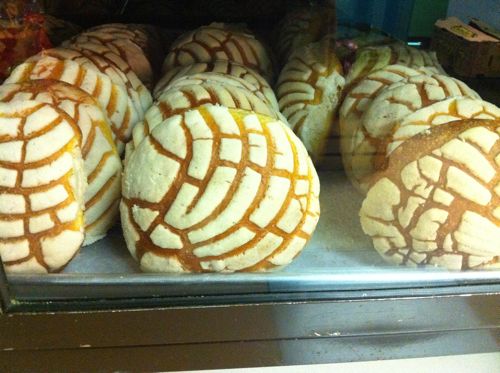Melon Pan vs. Concha Bread
There’s been a little debate brewing in the comment fields as to the difference between Japanese melon pan and Mexican concha (“seashell”) bread. The Pastry family happened to be out dining on Mexican food this past Saturday and we passed a Mexican bakery. I went in and snapped this close-up photo:

Having finally made melon pan, I can say that the concept behind the two is virtually the same: a fluffy roll covered in a cookie dough that’s scored for decoration. My take on the difference is that the Japanese version has a higher cookie-to-bread ratio and is somewhat sweeter. Melon pan is also quite a bit smaller. Given that both Mexico and Japan have had exposure to the southern European baking tradition, I suspect that both breads have a common ancestor, but I can’t find it. If anyone is aware of Portuguese, Spanish or French bread that’s made in this way please get in touch, because I’m stumped.
Is there some connection to tiger bread or Dutch crunch. It has some connection to SE Asia.
I’ll look into it, Stewart. Thanks for that clue.
I’m sure there is since the Dutch had exclusive trading rights with the Japanese for over two hundred years when the shoguns of the times prohibited all Westerns from arriving and trading with Japan except the Dutch.
Is this at all similar to pan dulce? That’s what the appearance reminds me of…
As far as I know “pan dulce” refers to a family of sweet breads, of which seashell bread (“concha”) is one. Thanks for the email, SCG!
Pan dulce literally translates to sweet bread. There’s many types of pan dulce, ie: empanadas, conchas, bigotes, and many more.
Chinese love eating Bolo bread, with the criss cross crunch on top of soft sweet bread looking like pineapple skin, thus it’s called “pineapple” bread. It’s the number selling bread in most of the bakeries in Taiwan and Chinese bakeries.
That’s close to the same thing, is it not, Yin? Thank you for this comment.
– Joe
as far as I know, the crunch on Dutch crunch is not sweetened, but Concha, Bolo, Melon bread’s crunch are all sweetened.
Again, very helpful. Thank you.
I have an idea of where it might come from: being that I am not aware of how far back the melon bread came about, if it’s a recent invention within the last hundred years, I suspect it may have come to Japan through the Philipines. During WWII, Japan took many Filipino women/girls back to Japan as sex slaves and who knows how many countless were forced to marry Japanese men. Being that the Spanish colonized the island, they must have brought this bread there, and then the Filipino women took it to Japan. Being that the Japanese do not teach WWII in schools and they deny most of it even today, they would not admit to where this bread came from soley because of how it came to Japan. Again, this is just a guess I came up with because I have taken several histroy classes and have several books about the atrocities the Japanese did during that time and how they made sex slaves out of many non-Japanese women. Woem as we all know are the ones that cook in homes and they would be the ones to pass down to their daughters their cooking knowledge.
That’s a fascinating theory, Maria, and certainly not outside the realm of possibility. I greatly appreciate you taking the time to write to me. It’ll make a great addition to the post!
– Joe
The Portuguese were the first Europeans to arrive in Japan in the 17th century. This could be a link. However, the Filipino theory hold more water since both the Philippines and Mexico have a connection with Spain. It may have been introduced during the Japanese occupation of the Philippines.
Thanks for all the good noodling on this, Nathan! I appreciate it!
– Joe
The Japanese wikipedia page says that melon pan has been in existence in Japan since last 19th century to post WWI. Unfortunately, it doesn’t mention its roots before that, but I think it’s likely that the Japanese got it directly from the Europeans (especially the Dutch, Spanish, English, and Italian, which they’ve had relations since at least mid 19th century).
Hey Lisa,
I’m sure that’s true…back at some point those fluffy breads came from the occident. Sadly we’ll probably never know when or from whom. Thanks for the email!
– Joe